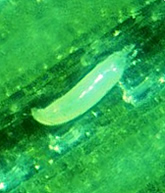This page has been archived and is being provided for reference purposes only. The page is no longer being updated, and therefore, links on the page may be invalid.
|
|
Scientists Set to Release New Disease-Resistant Wheat
By Jan SuszkiwDecember 4, 2007
'Mace', a new winter wheat cultivar developed by Agricultural Research Service (ARS) scientists and cooperators, could give growers an added measure of insurance against outbreaks of wheat streak mosaic virus (WSMV).
According to ARS plant geneticist Robert Graybosch, Mace harbors a gene called Wsm-1 that confers resistance to the virus, which is spread by the wheat curl mite, Aceria tosichella.
Spraying pesticide to prevent the mite from feeding and transmitting WSMV isn't particularly effective, so growers typically resort to using a combination of strategies, such as controlling weedy grasses and "volunteer" wheat. Both are sources of WSMV that the mites can acquire through feeding.
Even then, outbreaks of the virus can still occur. In the Great Plains, yearly outbreaks of WSMV claim about five percent of the region's wheat crop. Losses can be higher, as was the case in 1995, when an outbreak in Montana caused $35 million in yield losses there.
This winter, following more than 10 years of research, development and evaluation, Mace will be made available to wheat breeders and growers as foundation seed. 'RonL', a Kansas State University release, is the only other U.S. wheat cultivar with resistance to WSMV. However, this resistance seems to fade when temperatures climb to 70 degrees Fahrenheit or higher, notes Graybosch. He works at the ARS Grain, Forage and Bioenergy Research Unit in Lincoln, Neb.
Temperature sensitivity isn't an issue with Mace, which inherited its virus resistance from CI 17884, a wheat germplasm line that carries a chromosome for the trait from an intermediate wheatgrass. Graybosch codeveloped and tested the new wheat line with scientists at the ARS Lincoln unit, the University of Nebraska, and Kansas State University.
In two years of field trials at sites throughout Nebraksa, Mace produced grain yields equal to 'Wesley' and 'Millennium', two commercial varieties. In virus-infected fields, however, Mace's yields were two to three times higher than these and other commercial varieties the scientists used for comparison.
Graybosch is handling seed requests for the new wheat line.
ARS is the U.S. Department of Agriculture's chief scientific research agency.

